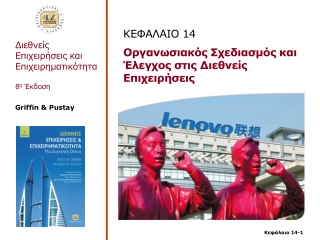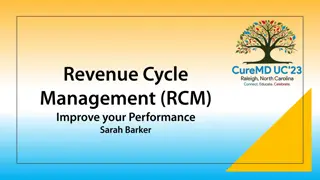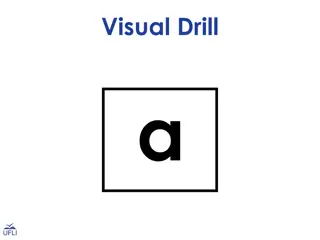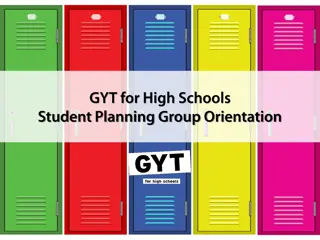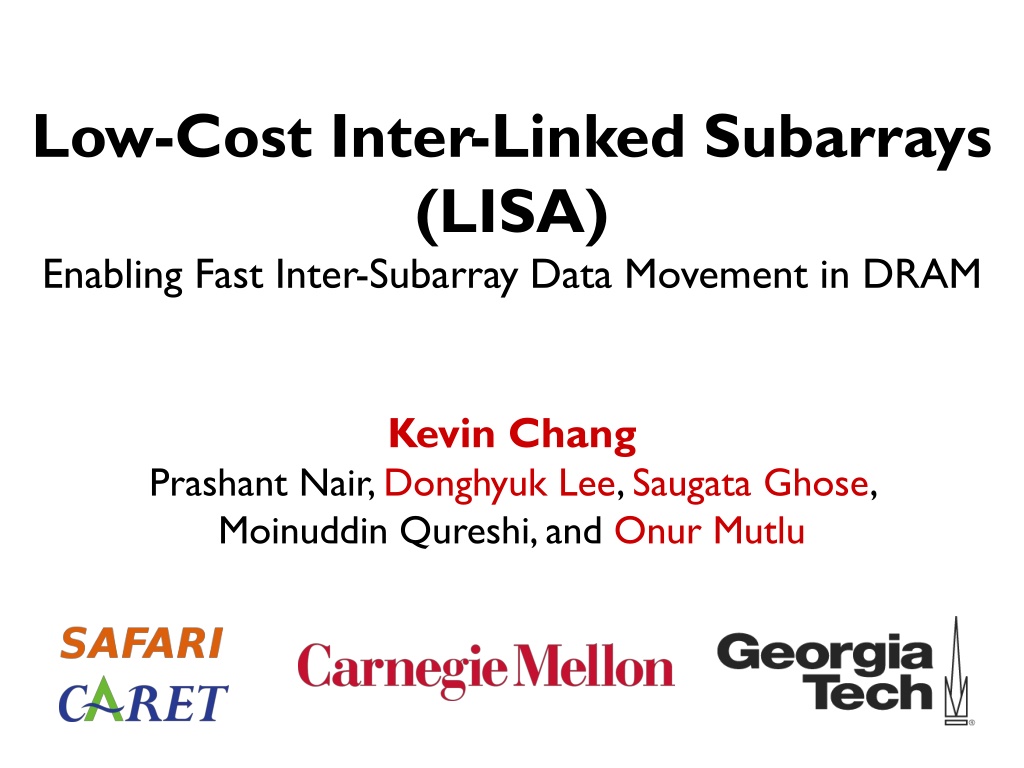
Fast Inter-Subarray Data Movement in DRAM with LISA
Discover how Low-Cost Inter-Linked Subarrays (LISA) revolutionize DRAM technology by enabling fast bulk data movement between subarrays, addressing the bottleneck issues with low connectivity. See the key ideas, applications, and benefits of using LISA in this innovative approach.
Download Presentation

Please find below an Image/Link to download the presentation.
The content on the website is provided AS IS for your information and personal use only. It may not be sold, licensed, or shared on other websites without obtaining consent from the author. If you encounter any issues during the download, it is possible that the publisher has removed the file from their server.
You are allowed to download the files provided on this website for personal or commercial use, subject to the condition that they are used lawfully. All files are the property of their respective owners.
The content on the website is provided AS IS for your information and personal use only. It may not be sold, licensed, or shared on other websites without obtaining consent from the author.
E N D
Presentation Transcript
Low-Cost Inter-Linked Subarrays (LISA) Enabling Fast Inter-Subarray Data Movement in DRAM Kevin Chang Prashant Nair, Donghyuk Lee, Saugata Ghose, Moinuddin Qureshi, and Onur Mutlu
Problem: Inefficient Bulk Data Movement Bulk data movement is a key operation in many applications memmove & memcpy:5% cycles in Google s datacenter [Kanev+ ISCA 15] Core Core Controller Memory src LLC Channel 64 bits dst Core Core CPU Memory Long latency and high energy 2
Moving Data Inside DRAM? 8Kb 512 rows Bank Subarray 1 Subarray 2 Subarray 3 Bank DRAM cell Bank Bank DRAM Subarray N Internal Data Bus (64b) Low connectivity in DRAM is the fundamental Low connectivity in DRAM is the fundamental bottleneck for bulk data movement bottleneck for bulk data movement wide connectivity between wide connectivity between subarrays Goal: Provide a new substrate to enable Goal: Provide a new substrate to enable subarrays 3
Key Idea and Applications Low-cost Inter-linked subarrays (LISA) Fast bulk data movement between subarrays Wide datapath via isolation transistors: 0.8% DRAM chip area Subarray 1 Subarray 2 LISA is a versatile substrate new applications Fast bulk data copy: Copy latency 1.363ms 0.148ms (9.2x) 66% speedup, -55% DRAM energy In-DRAM caching: Hot data access latency 48.7ns 21.5ns (2.2x) 5% speedup Fast precharge: Precharge latency 13.1ns 5.0ns (2.6x) 8% speedup 4
Outline Motivation and Key Idea DRAM Background LISA Substrate New DRAM Command to Use LISA Applications of LISA 5
DRAM Internals Subarray Subarray Internal Data Bus Bitline Decoder Wordline Row 512 x 8Kb S P S P S P S P 64b Row Buffer Sense amplifier Precharge unit I/O S P Bank (16~64 SAs) 8~16 banks per chip 6
DRAM Operation 1 ACTIVATE: Store the row into the row buffer 1 1 1 1 2 READ: Select the target column and drive to I/O To Bank I/O S P S P S P S P 3 PRECHARGE: Reset the bitlines for a new ACTIVATE Vdd/2 Vdd Bitline Voltage Level: 7
Outline Motivation and Key Idea DRAM Background LISA Substrate New DRAM Command to Use LISA Applications of LISA 8
Observations 1 Bitlines serve as a bus that is as wide as a row Internal Data Bus (64b) S P S P S P S P 2 Bitlines between subarrays are close but disconnected S P S P S P S P 9
Low-Cost Interlinked Subarrays (LISA) Interconnect bitlines of adjacent subarrays in a bank using isolation transistors (links) S P S P ON S P S P 8kb 64b S P S P S P S P LISA forms a wide datapath b/w subarrays 10
New DRAM Command to Use LISA Row Buffer Movement (RBM): Move a row of data in an activated row buffer to a precharged one Subarray 1 Vdd Vdd Vdd- Activated S P S P S P S P on Charge Sharing RBM: SA1 SA2 Subarray 2 Vdd Vdd/2 Vdd/2+ Precharged Activated RBM transfers an entire row b/w subarrays S P S P S P S P Amplify the charge 11
RBM Analysis The range of RBM depends on the DRAM design Multiple RBMs to move data across > 3 subarrays Subarray 1 Subarray 2 Subarray 3 Validated with SPICE using worst-case cells NCSU FreePDK 45nm library 4KB data in 8ns (w/ 60% guardband) 500 GB/s, 26x bandwidth of a DDR4-2400 channel 0.8% DRAM chip area overhead [O+ ISCA 14] 12
Outline Motivation and Key Idea DRAM Background LISA Substrate New DRAM Command to Use LISA Applications of LISA 1. Rapid Inter-Subarray Copying (RISC) 2. Variable Latency DRAM (VILLA) 3. Linked Precharge (LIP) 13
1 1. Rapid Inter-Subarray Copying (RISC) Goal: Efficiently copy a row across subarrays Key idea: Use RBM to form a new command sequence Subarray 1 src row 1 Activate src row S P S P S P S P 2 2 RBM SA1 SA2 Subarray 2 dst row Reduces row-copy latency by 9.2x, 3 3 Activate dst row (write row buffer into dst row) DRAM energy by 48.1x S P S P S P S P 14
Methodology Cycle-level simulator: Ramulator [CAL 15] https://github.com/CMU-SAFARI/ramulator CPU: 4 out-of-order cores, 4GHz L1: 64KB/core, L2: 512KB/core, L3: shared 4MB DRAM: DDR3-1600, 2 channels Benchmarks: Memory-intensive: TPC, STREAM, SPEC2006, DynoGraph, random Copy-intensive: Bootup, forkbench, shell script 50 workloads: Memory- + copy-intensive Performance metric: Weighted Speedup (WS) 15
Comparison Points Baseline: Copy data through CPU (existing systems) RowClone [Seshadri+ MICRO 13] In-DRAM bulk copy scheme Fast intra-subarray copying via bitlines Slow inter-subarray copying via internal data bus 16
System Evaluation: RISC RowClone RISC 75 66% 60 55% Over Baseline (%) Rapid Inter-Subarray Copying (RISC) using LISA 45 30 15 5% 0 -15 Degrades bank-level parallelism -24% -30 WS Improvement improves system performance DRAM Energy Reduction 17
2 2. Variable Latency DRAM (VILLA) Goal: Reduce DRAM latency with low area overhead Motivation: Trade-off between area and latency Long Bitline (DDRx) Short Bitline (RLDRAM) Shorter bitlines faster activate and precharge time High area overhead: >40% 18
2 2. Variable Latency DRAM (VILLA) Key idea: Reduce access latency of hot data via a heterogeneous DRAM design [Lee+ HPCA 13, Son+ ISCA 13] VILLA: Add fast subarrays as a cache in each bank 512 rows frequent movement of data rows Challenge: VILLA cache requires Slow Subarray 32 rows LISA: Cache rows rapidly from slow to fast subarrays Fast Subarray Reduces hot data access latency by 2.2x at only 1.6% area overhead Slow Subarray 19
System Evaluation: VILLA 50 quad-core workloads: memory-intensive benchmarks 80 1.16 Max: 16% VILLA VILLA Cache Hit Rate 70 Normalized Speedup 1.14 VILLA Cache Hit Rate (%) 60 1.12 50 1.1 40 1.08 30 1.06 Avg: 5% 20 1.04 1.02 Caching hot data in DRAM using LISA improves system performance 10 1 0 Workloads (50) 20
3 3. Linked Precharge (LIP) Problem: The precharge time is limited by the strength of one precharge unit Linked Precharge (LIP): LISA precharges a subarray using multiple precharge units S P S P S P S P S P S P S P S P on Activated row Linked Precharging Precharging Reduces precharge latency by 2.6x (43% guardband) S P S P S P S P S P S P S P S P on on Conventional DRAM LISA DRAM 21
System Evaluation: LIP 50 quad-core workloads: memory-intensive benchmarks 1.16 LIP Normalized Speedup 1.14 Max: 13% 1.12 1.1 Avg: 8% 1.08 1.06 1.04 1.02 Accelerating precharge using LISA Accelerating precharge using LISA improves system performance improves system performance 1 Workloads (50) 22
Other Results in Paper Combined applications Single-core results Sensitivity results LLC size Number of channels Copy distance Qualitative comparison to other hetero. DRAM Detailed quantitative comparison to RowClone 23
Summary Bulk data movement is inefficient in today s systems Low connectivity between subarrays is a bottleneck Low-cost Inter-linked subarrays (LISA) Bridge bitlines of subarrays via isolation transistors Wide datapath with 0.8% DRAM chip area LISA is a versatile substrate new applications Fast bulk data copy: 66% speedup, -55% DRAM energy In-DRAM caching: 5% speedup Fast precharge: 8% speedup LISA can enable other applications Source code will be available in April https://github.com/CMU-SAFARI 24
Low-Cost Inter-Linked Subarrays (LISA) Enabling Fast Inter-Subarray Data Movement in DRAM Kevin Chang Prashant Nair, Donghyuk Lee, Saugata Ghose, Moinuddin Qureshi, and Onur Mutlu

